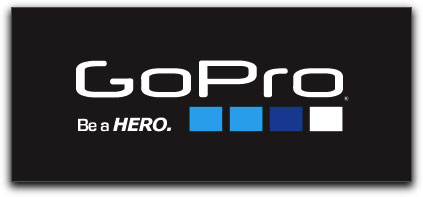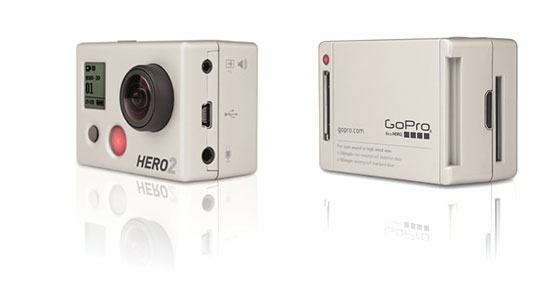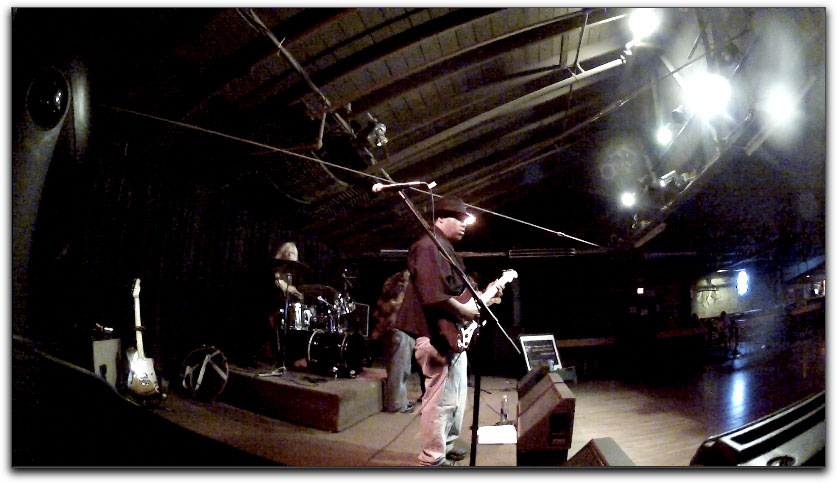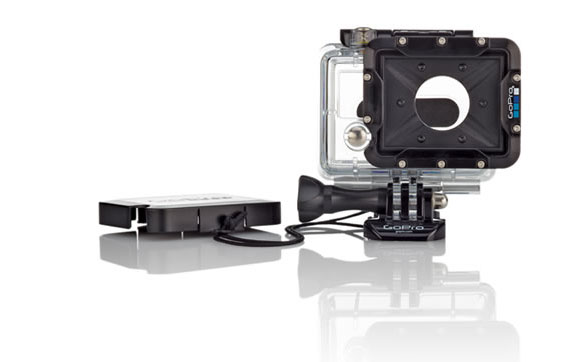



October, 2012
 GoPro HD HERO2
GoPro HD HERO2
GoPro Hero
$299.99
Review by Steve Douglas
When the original GoPro was introduced into the market it immediately filled a niche for a great many people who would probably have not gotten into video or whose budgets simply didn't allow for it. As I used the first GoPro HERO to come out, all I could think of was that I wished I had had one when I spent my twenties jumping out of planes every weekend. The current group of skydivers,motorcyclists, BMX riders, skateboard pros and amateurs alike grabbed onto the GoPro like a thirsty man jumping into a desert pool at an oasis.

The only problem then was that there was no back monitor so setting your shot up was a bit of a hit and miss. GoPro listened to its customers and soon came out with a monitor which enabled you to create the composition of your choosing.
Soon after, many different companies jumped onto the POV bandwagon with their own small cams and many of them have been reviewed here as well. However, of all of them, I found the GoPro to top them all in terms of the quality of the footage, ease of use and overall flexibility in how and where they could be used.
My only issue with the original GoPro HERO was its menu system which I found confusing and difficult to navigate.
When the new GoPro HD HERO2 was introduced, I decided to really live with it awhile and use it frequently in many filming situations before I actually wrote the review you are now reading. There have been many improvements to this new version of the GoPro HD HERO2, and having used it as often as I have has made a heck of a positive impression.
To start off with, the new menu, my biggest area of concern is no concern at all anymore. It has been greatly modified to make using it so much easier and more intuitive. You simply press the front power button to turn it on, the top button to easily navigate through the photo, video, time-lapse or other shooting modes and features, each marked by a large, easy to see icon, and film away.
The new HD HERO2 has 2x faster image processor and a 6.45x4.6 size. The original GoPRO HERO's sensor was 5.76x4.29. This translates into both sharper video and photo results.
When comparing the original GoPro HERO to the latest version you will find several other significant improvements. For those shooting still photos, the original could shoot at a rate of 3 photos in 2 seconds, but the new HD HERO2 will now take 10 photos in 1 second, a marked improvement. It has also added the ability to shoot photos as either an 11, 8 or 5 megapixel shots compared to the previous 5 MP photos of the original.
The Time Lapse feature added a .5 second time lapse ability to its previous 1,2, 10, 30 and 60 second self timer.
There are also major improvements to the video quality itself. It will still shoot a 16x9 1920x1080 clip with the same wide 170° fisheye appearance but you can now change the zoom length in the camera menu to either a medium 127° or a narrow 90°. These options also apply to the other filming resolutions whether shooting at 960p, 720p and even WVGA as well as when shooting at 60FPS for a smooth slow motion clip.
The new GoPro HD HERO2 now has a mini-HDMI port for viewing on your HD monitor, and a new 3.5mm stereo external microphone input for more professional productions. The current internal microphone does have dual audio settings for capture of natural sound or a new high velocity mode to tune out wind noise. In truth, if you can use the new audio inputs for your own microphone you will be better off as the internal mic does not really record a usable audio file for serious editing purposes and projects.
This brings me to an interesting example of just how good the GoPro HD HERO2 is. I recently played a showcase with my band, The Bi-Polar Blues Band, at a local club. Just for kicks, I placed the new HD HERO2 on top of a speaker at stage right. I also placed a competitors POV cam on the speaker at stage left. Both cams were exposed to the same overly bright stage lights in this otherwise darkly lit club and both were set to the same frame rates and format size. The next day I downloaded the video. The footage from the competitor's cam was so dark, it was akin to seeing a black screen and nothing more. The footage from the new GoPro HD HERO2 was more than usable, and while there is not a whole lot of color resolution to the image, it captured the entire set list just fine. This improvement in the quality of the footage in low light situations can certainly be ascribed to the larger and faster sensor.

With the GoPRO HERO2's video setting set to a full 1920x1080 at 30fps, when filming in a dark club, I wasn't sure what to expect. While there is certainly grain due to the low light situation, the footage caught the magic and sounds of the evening. I'm looking over from the drums to see that one of the 4 LEDs on the GoPRO HERO2 was still blinking and recording. Despite the stage lights blowing out part of the image, I was still able to get very decent footage.
For the underwater enthusiast, GoPro has also brought out their new housing whose new port greatly reduces the distortion produced with their original underwater housing. It contains room for the use of their optional BacPac monitor for easy set up of photo and video composition as well as an attached lens cover to protect the lens when not in use.

The latest in underwater housings for the new GoPro HD HERO 2 is made of a tough polycarbonate material and is rated to a depth of 180 feet, which is deeper than most divers usually go. However, the next time I dive to over 200 feet, I will have the GoPRO HERO2 with me for that important B roll POV footage and I am betting the housing and cam will hold up just fine.

Taken from a frame of video shot with the new housing, you can see that, even un-retouched, there is more detail and color than with the original GoPro HERO.
As always, the GoPro can be mounted most anywhere, on a car, motorcycle, skateboard or in those areas where a full sized camera or camcorder just wouldn't fit.

Using a strap secured by the divers hood, the GoPro HD HERO2 can supply hands free POV shots. Just don't shake your head too much.
Topside use of the GoPro HD HERO2 not only produces deeper color saturation but also is considerably better in low light situations. Due to its light weight, as would be with any small camcorder, hand holding a GoPro is a challenge if you want to avoid the shaky footage that handholding can often produce. On the other side of the coin, for those using the GoPro to record their ski runs, jet ski and motorbike excursions the bumps and shakes become part of the video that creates the 'You Are There' experience.
There are so many uses for the new GoPro HD HERO2 it is hard to fathom. I recently took a lesson from renowned drummer Ron Haslam. Knowing I might forget some of the intricate patterns he was demonstrating for me, I decided to use the GoPro HERO2 to film the segment. There was no elaborate setup, it was just me handholding the HERO2 in his small studio. The footage, as seen below, both video and audio, came out just fine. I offloaded the footage to my MacPro, used Handbrake to convert it to an mp 4 and imported it into iTunes. From there I placed it on my old iPod 3 and could then bring it to my drum kit to watch as I repeated Ron's patterns for practice purposes.

Record your child's instrument lessons, dance recitals or anything that inspires you at a moments notice.
Here, drummer Ron Haslam explains the complex pattern he had just played.
The GoPro HD HERO2 will support SD cards of up to 32 GB which would provide for a pretty darn long shoot. I have noticed that the HERO2, after being on for awhile, can get pretty warm, so heat is definitely being generated. However, over a great many uses with HERO2 I have not noticed any detrimental result due to the heat. Perhaps it is caused by the HERO2's integrated battery warmer which enables a longer battery life, but I can't really say. After further investigation I was told that there is heat protection built into the camera that will cause the GoPro HERO2 to shut itself off if its temperature gets too high, something like 115° or so, however, this has never happened any time I have used it.
As with many camcorders and cameras, new firmware updates are made available every so often so it is important to check on GoPro's website to see if you have the latest. I had no idea which my last update was but I had fortunately saved the installer in my downloads folder only to see that there, indeed, was a new firmware update waiting for me. The process of updating was fairly simple. After downloading the firmware.zip file to my Mac Pro, I was required to install GoPro's CineForm Studio application on the computer. I made sure that the HERO2 was turned off and unplugged from the Mac. Once the CineForm Studio was installed but closed, and double checking that an SD card was in the HD HERO2 camera, I could then turn on the HD HERO2 and connect it to the Mac Pro via USB cable. The next step was to open the CineForm Studio software application and a dialog box appeared letting me know that an update was available. Click on 'Update' and CineForm will automatically download and install the new firmware which it did without a hitch.
In the past, I have always used either Handbrake or MPEG StreamClip to do my video conversions for me before importing into either Final Cut Pro or Premier Pro. Never the less, I thought I would take a very quick look at CineForm Studio.

The interface for GoPro's CineForm Studio
Using the 'Import New Files' button on the upper left of the interface you can direct CineForm Studio to import a single video file or an entire folder of files. Using the 'Remove Clip' button will eliminate any clips that you have decided not to use or the 'Clear All' button will do just that, remove all video files. By highlighting any one clip in this file queue, the clip will then be brought up in the main interface window where you can set in and out points for conversion as well as rename the clip to something more identifiable than 'GoPro 121.MP4'.
By clicking on the Advanced Settings box, a drop-down window opens where you can adjust the video quality of the conversion as well as frame rate and image size.

By default, conversions are sent to your 'Movies' folder so I clicked on the 'changed directory' at the bottom to have any file go to my desktop.
In CineForm Studio you can also use its Color Editing tools to adjust the color, saturation and position of your clips.

Crushed the blacks and adjusted for clip rotation on this clip.

For those using the GoPro for 3D filming, you can use the CineForm Studio to do much of the work for you prior to converting the frame size or rate
In truth, I found the CineForm application to be a touch wonky. Sometimes the buttons simply would not respond, the conversion bar would stop mid-way even though the conversion had been successfully completed, and sometimes clicking on the step 2 Edit screen would cause the main interface window to go completely black. I also suffered through 2 separate CineForm Studio application crashes. Sometimes it worked, sometimes it didn't so I think I will stick to my tried and true past methods of video conversion.
This, in no way, detracts from the impressive quality of the GoPro HD HERO2. This new camera version is no slight improvement. It is a major upgrade in all ways and areas highlighted by its new, faster and larger sensor and its wonderful new menu which makes utilizing the GoPro HERO2 an extremely useful filming tool. As I alluded to earlier, the GoPro HERO2 beats all competitors in this niche of camcorder/cameras hands down.
 Steve Douglas is a certified Apple Pro for Final Cut Pro 7 and underwater videographer. A winner of the 1999 Pacific Coast Underwater Film Competition, 2003 IVIE competition, 2004 Los Angeles Underwater Photographic competition, and the prestigious 2005 International Beneath the Sea Film Competition, where he also won the Stan Waterman Award for Excellence in Underwater Videography and 'Diver of the Year', Steve was a safety diver on the feature film "The Deep Blue Sea", contributed footage to the Seaworld Park's Atlantis production, and productions for National Geographic and the History channels. Steve was a feature writer for Asian Diver Magazine and is one of the founding organizers of the San Diego UnderSea Film Exhibition. He is available for both private and group seminars for Final Cut Pro and leads underwater filming expeditions and African safaris with upcoming excursions to the Philippines, Bali, Raja Ampat, Indonesia, and the Maldives Islands. Feel free to contact him if you are interested in joining Steve on any of these exciting trips. www.worldfilmsandtravel.com
Steve Douglas is a certified Apple Pro for Final Cut Pro 7 and underwater videographer. A winner of the 1999 Pacific Coast Underwater Film Competition, 2003 IVIE competition, 2004 Los Angeles Underwater Photographic competition, and the prestigious 2005 International Beneath the Sea Film Competition, where he also won the Stan Waterman Award for Excellence in Underwater Videography and 'Diver of the Year', Steve was a safety diver on the feature film "The Deep Blue Sea", contributed footage to the Seaworld Park's Atlantis production, and productions for National Geographic and the History channels. Steve was a feature writer for Asian Diver Magazine and is one of the founding organizers of the San Diego UnderSea Film Exhibition. He is available for both private and group seminars for Final Cut Pro and leads underwater filming expeditions and African safaris with upcoming excursions to the Philippines, Bali, Raja Ampat, Indonesia, and the Maldives Islands. Feel free to contact him if you are interested in joining Steve on any of these exciting trips. www.worldfilmsandtravel.com
copyright © Steve Douglas 2012
This article first appeared on www.kenstone.net and is reprinted here with permission.
All screen captures and textual references are the property and trademark of their creators/owners/publishers.